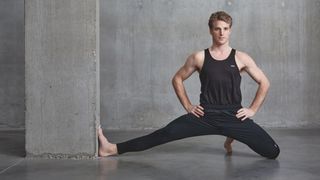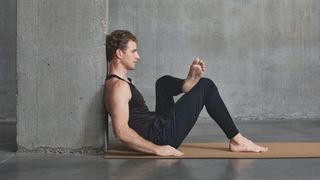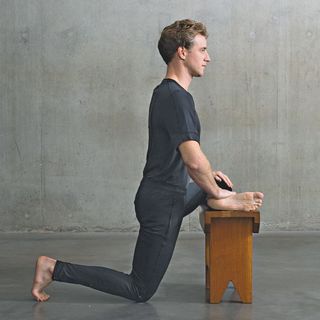
First question: are you sitting comfortably?
Roger Frampton certainly appears to be, legs crossed on the floor, as we discuss his new book, Stretch: Seven Daily Movements to Set Your Body Free. And that’s because he’s already spent the morning releasing and realigning his spine, hips and shoulders from the rigours of modern life.
Since qualifying as a movement coach in 2011, the 37-year-old has become a mobility missionary, spreading the good word of conscious movement, bodyweight exercises, gymnastics and yoga to his many thousands of followers across Instagram and YouTube. And his influence is growing: his 2016 TED Talk, Why Sitting Down Destroys You, has been viewed over four million times.
In 2018 Frampton published his first book, The Flexible Body, exploring this theme. Now, with Stretch, Frampton has drawn up a seven-step action plan to reverse the damage of our sedentary life and help us regain the fluid movement we took for granted as kids.
We joined him (on the floor, naturally) via video call to learn more about his new book, and asked him for some hip mobility drills to help us get back off the floor.
What are the seven daily movements covered in Stretch?
“These movements focus on the critical areas of the body, specifically the spine, hips and shoulders, as well as your balance, which is essential for overall mobility,” says Frampton. “We also cover common problem areas, like the IT band and hip flexors, which can lead to pain and injury.
“The book includes seven principal stretches, with variations on each, that will help improve everyday movement. Each exercise takes just a minute to perform and there are six levels you can build up to, depending on your flexibility and mobility.”
Get the Coach Newsletter
Sign up for workout ideas, training advice, reviews of the latest gear and more.
Is it all beginner-friendly?
“This book is for those just wanting to get started. I want it to resonate with people’s parents and grandparents, and especially for those who sit at a desk for eight hours a day.
“At the same time, it will help anyone looking to get stronger. It doesn’t matter if you’re 25 or 75. Everything in the book is scalable and starts with just seven minutes a day. As long as your body isn’t getting any tighter, you’re making huge progress.”
Can stretching make you stronger too?
“In gymnastics, which is an inspiration for much of my coaching, as you improve in your flexibility the strength movements become easier because you have more range of motion in your body. Whereas if you’re tight, you’re essentially fighting your own body.
“Because gymnasts are so flexible, they make strength moves look basic. For example, with a handstand, if you have flexible shoulders, a handstand should feel like no more effort than just standing. So by stretching regularly, using this book, people will find their flexibility, mobility and strength will all improve.”
In the book you say sitting is as bad for your health as smoking – so what should we do instead?
“There’s nothing wrong with sitting in a chair. The problem is if we’re always in the same position. The same is true with sports, like running, which involve repetitive movements. If that’s all you do it will eventually become problematic. Stretching is about variety and getting the body moving in different ways.”
Try these three tips from Frampton to avoid some of the problems that can come with too much sitting.
- Imagine you have a tail. To avoid crushing it, you have to sit on your legs, not your bottom. It will naturally help untuck your pelvis and raise your chest for a better posture.
- Uncross everything. Feet, arms, legs. Constant crossing, because it’s always on the same side, will twist your body into pain points. I know it’s comfortable but it’s a habit that you can break.
- Finally, and especially if you’re working from home, sit on the floor, sit against a wall, kneel, stand. Mix it up throughout the day so you don’t get locked into one repetitive position.
See related
- Four Back Stretches And Exercises To Prevent Painful Problems
- Loosen Up With This Full-Body Stretching Routine
- Treat Your Body To This 10-Minute Stretching Workout
- Three Easy Neck Exercises To Help Prevent Neck Pain
Three Essential Stretches For Hip Mobility
Now that we’ve cracked the curse of sitting, we asked Frampton for his go-to hip mobility drills from Stretch.
Remember, this set of stretches is just one of your seven essential daily movements, alongside four for the spine, one for the shoulders and one for balance, but it’s a good place to start if you want to keep your lower back and knees pain free.
“Ideally you should use these stretches after a workout, when you’re warm,” says Frampton. “If you’re doing them first thing in the morning when you’re cold, start light. Aim for around a four or five out of 10 for intensity and build it up over time.
“Aim for a minute on each side, building up to three minutes on each.”
1 Lazy wall stretch

All you need is a wall and a mat or firm-gripping surface to stop you sliding away mid-stretch.
Sit in a very slouched position with your back leaning against a wall and your legs out straight in front of you. Next, bend your right knee so the sole of your right foot is on the floor – you want the sole of the foot to be in contact with the floor at all times because you will use this as leverage. Next, pick up your left foot and place it on your right thigh. For more of a stretch, place the foot on the thigh; for less, lay your ankle on the thigh.
This is your base position. You can then make two adjustments to increase the stretch. Bring the sole of the right foot closer or sit up taller on the wall.

“For maximum stretch over time, work towards getting your lower back closer to the wall. As you progress, focus on lifting the chest to advance the stretch,” says Frampton.
2 Single-leg frog

This move targets the groin, but it can also be beneficial for the calves, hamstrings, hip flexors and quads. We recommend doing it on a mat with your heel and knee cushioned.
To begin, kneel on the floor next to a wall. Extend your right leg out to the side until your right foot is flat against the wall, toes pointing up and heel on the floor. Once comfortable, and really the key is comfort here, wiggle your left knee out as far away from the wall as you can while still remaining upright. You could also hold on to something in front of you, like a chair, and build up to placing your hands on your hips. Push your hips forwards to engage your glutes and increase the stretch.
“On the supporting leg, your heel and your knee should be in a straight line,” adds Frampton. “The toes can be tucked or untucked (pointing straight behind you). As you progress, the distance between the supporting knee and the opposite heel will increase.”
3 Elevated pigeon

This is one of Frampton’s favourite stretches, and he suggests using a sofa, low chair or table with a soft yoga block on top, and a mat or cushion under the knee.
Place your shin on top of the sofa, chair or low table so it is perpendicular to your body, and lower your back knee to the floor. If your raised knee doesn’t lie flat, use a couple of yoga blocks or cushions to support it. Over time it will be able to go lower. The shin of your back leg might rotate inwards because your hip is rotating out to one side. To combat this, squeeze the glute on your back leg. You may also get a bit of a quad and hip flexor stretch at the same time. Keep your body upright and try to relax into this position, then change over to the other side.
“As the heights [of the objects you might use] are so varied, the concept of what we are trying to achieve is most important,” says Frampton. “Essentially, the higher the surface I use, the more challenging the exercise becomes and the stronger the stretch is going to be.”
Stretch: Seven Daily Movements to Set Your Body Free by Roger Frampton is out now (£14.99, Pavilion Books)

Sam Rider is an experienced freelance journalist, specialising in health, fitness and wellness. For over a decade he's reported on Olympic Games, CrossFit Games and World Cups, and quizzed luminaries of elite sport, nutrition and strength and conditioning. Sam is also a REPS level 3 qualified personal trainer, online coach and founder of Your Daily Fix. Sam is also Coach’s designated reviewer of massage guns and fitness mirrors.
